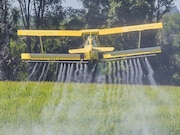Increased risk seen for autism spectrum disorder and disorder with comorbid intellectual disability
FRIDAY, March 22, 2019 (HealthDay News) — Prenatal exposure to ambient pesticides within 2,000 m of maternal residence during pregnancy is associated with an increased risk for autism spectrum disorder, according to a study published online March 20 in The BMJ.
Ondine S. von Ehrenstein, M.P.H., Ph.D., from the University of California in Los Angeles, and colleagues conducted a population-based study using 1998 to 2010 birth data for California’s main agricultural region (Central Valley). Data were included for 2,961 individuals with a diagnosis of autism spectrum disorder, including 445 with intellectual disability comorbidity, and controls matched 10:1 by sex and birth year. Prenatal and infant exposures to 11 high-use pesticides were measured within 2,000 m from maternal residence.
The researchers found that the risk for autism spectrum disorder correlated with prenatal exposure to glyphosate, chlorpyrifos, diazinon, malathion, avermectin, and permethrin (odds ratios, 1.16, 1.13, 1.11, 1.11, 1.12, and 1.10, respectively). The estimated odds ratios for autism spectrum disorder with intellectual disability were higher for prenatal exposure to glyphosate, chlorpyrifos, diazinon, permethrin, methyl bromide, and myclobutanil (odds ratios, 1.33, 1.27, 1.41, 1.46, 1.33, and 1.32, respectively). For some pesticide substances, the odds for the disorder with comorbid intellectual disability were increased by up to 50 percent with exposure in the first year of life.
“From a public health and preventive medicine perspective, our findings support the need to avoid prenatal and infant exposure to pesticides to protect early brain development,” the authors write.
Copyright © 2019 HealthDay. All rights reserved.








